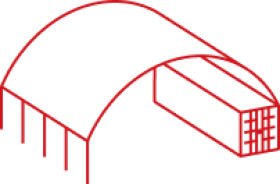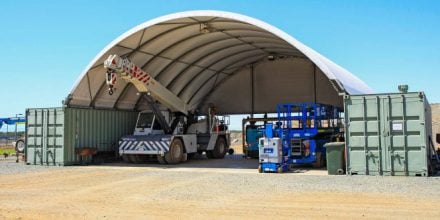
Winter weather can be a challenging time for companies in many industries, from transport and logistics to mining and construction. Heavy rain and storms can damage equipment, disrupt workflow, and cause costly amounts of downtime. But what if there was a way to control the impact of these harsh weather conditions on your operations?
DomeShelter™ Structures have given thousands of companies sheltered areas that allow uninterrupted operations and protection of people and assets without the concern of weather damage.
DomeShelter Australia also offers weather control add-ons that can further enhance the performance and efficiency of Fabric Shelters in harsh conditions. Options such as guttering systems and tropical roofs allow the customisation of all DomeShelter™ products to suit the specific needs of every client.
In this article, we will explore ways you can customise your Shelter with weather control add-ons and look at their benefits and how they can help you prepare for the winter months ahead.
Why Are Weather Control Add-Ons Important?
All standard DomeShelter™ Structures are fully engineered to provide protection from the elements, but in areas with particularly high rainfall, weather control add-ons can add further protection from the potential damage caused by heavy rain, wind, and other extreme events.
Considering the nature of the contents within a Fabric Shelter is also important, as water escaping under weather flaps and running down the inside of a Shelter’s walls could interfere with electrical outlets or goods inside the Shelter, creating a safety hazard.
Weather control add-ons provide a shield against these scenarios and can prevent structures from damage. These add-ons can include various features such as gutter systems and tropical roofs, that divert water away from the structure, preventing potential damage. Additionally, these add-ons can also regulate the temperature and humidity levels inside the structure, creating a comfortable and safe environment for occupants and assets.
Gutter Systems: How They Work and Why You Need Them
Gutters prevent water ingress by channeling water away from the Structure’s walls and footings. Water collected by a gutter is fed, usually via a drainpipe, from the roof’s edge to the base of the building.
A gutter system is the simplest weather control system that is added to many Fabric Shelters to ensure the control of heavy rain. Gutters and drainpipes offer the ability to divert water to a certain point, rather than allowing rain to run straight off the roof onto the ground below, where it may pool and erode soil around the base of the Shelter/container. Gutters can be added to any or all sides of a Shelter. Some clients with several Shelters that are interconnected or ‘daisy chained’ will have gutters only for the points at which two Shelters connect, where water may be more likely to collect.
Tropical Roofs: Protecting Sea Containers
A tropical roof is constructed using corrugated steel sheeting and purlins to create a pitched roof for sea containers. The primary purpose of this pitch is to promote water run-off, protecting the containers and the greater Shelter from rainfall. A secondary benefit of tropical roofs is the airspace they create above the actual container roof, which helps to insulate.
Tropical roofs eliminate direct sunlight hitting the container roofs and also provide that insulating airspace, therefore helping to keep the entire container cooler. High capacity gutters can be added to tropical roofs to further optimise water management for the Shelter. Otherwise, rainfall can just flow off the edge of the tropical roof, though erosion should be considered in these cases.
Which Weather Control System Do I Need?
In general, the two main systems available for Fabric Shelters work in increments of severity, I.e. areas with normal rainfall would only require a gutter system to manage water. Areas with higher than normal rainfall may want to consider a tropical roof for better weather protection.
At the same time, it is worth considering the insulation benefits provided by a tropical roof system even in areas with lower rainfall, if high temperatures are experienced frequently. They can help to make Shelters cooler and improve the working environment within.
DomeShelter Australia
DomeShelter Australia is the industry leader in manufacturing Fit-For-Purpose, fully engineered Fabric Structures. The experienced DomeShelter™ team has designed countless Shelters with fully customised weather control systems to optimise their efficiency.
If you would like more information about weather control systems for Fabric Shelters, feel free to fill out the contact form on our website and one of our team will get in touch directly.




















